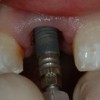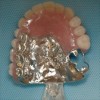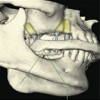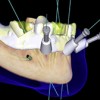The denture base must cover as large an area as functionally possible in order to idealize retention, stability and support. The most ideal denture base results from a so-called mucostatic impression (underlying mucsoa not deformed or compressed) custom final impression made on healthy, clean, normally contoured supporting tissues. This program demonstrates the use of a variety of techniques and materials used to obtain appropriately border molded master impressions.
Complete Dentures – Final Impressions — Course Transcript
- 1. 7. Final Impressions John Beumer III, DDS, MS, Robert Duell, DDS and Eleni Roumanas Division of Advanced Prosthodontics, Biomaterials and Hospital Dentistry UCLA School of Dentistry This program of instruction is protected by copyright ©. No portion of this program of instruction may be reproduced, recorded or transferred by any means electronic, digital, photographic, mechanical etc., or by any information storage or retrieval system, without prior permission.
- 2. Final Impressions
- 3. Impression Objectives Preservation -with the loss of the stimulation of the natural dentition the alveolar ridge will atrophy or resorb, the process can be hastened or retarded by local factors. Pressure in the impression technique is reflected as pressure in the denture base and results in soft tissue damage and bone resorption . Support – maximum coverage provides the “snow shoe” effect. Stability – close adaptation to the underlying mucosa is most important to reduce the horizontal movement of the denture. Esthetics – border thickness should be varied to restore facial contour and proper lip support. Retention -atmospheric pressure, adhesion, cohesion (depends on peripheral seal) mechanical locks, muscle control.
- 4. The basic differences in techniques for final impressions can be resolved as those that record the soft tissues in a functional position and those that record the soft tissues in the undisplaced or rest position. Soft tissues that are displaced and recorded in this position will attempt to return to the undisplaced position when the forces are released. -The dentures will be unseated from their bases by this tissue action. -When tissues are held in a displaced position, the pressure limits the normal blood flow . When normal tissues are deprived of their blood supply, the result is resorption. Impression Techniques
- 5. We attempt to record the tissues at rest. The only exception is the posterior palatal seal area Maxillary tuberosity Posterior palatine glands Posterior Palatal Seal
- 6. The selective pressure technique is a combination of extension for maximum coverage within tissue tolerance with light pressure or intimate contact with the movable, loosely attached tissues in the vestibules. The impression is refined with minimum pressure utilizing a wash of light body impression material. Selective Pressure Technique
- 7. Final Impressions Appointment: After establishing the health of the denture bearing areas final impressions are made. Try in custom impression tray and adjust the length of the flanges 2-3 mm short of the vestibule depth. Establish the three dimensional contours of the denture borders by border molding the custom tray utilizing a thermoplastic “compound” material. Final impression with a light body material to achieve a “ mucostatic ” final impression.
- 8. Instruct the patient to leave out their dentures for 24 hours prior to the final impression appointment. Final Impressions Appointment:
- 9. Armamentarium: Dental compound Kingsley scraper Slow speed handpiece Acrylic bur #7 wax spatula Indelible marking sticks Red handled knife Custom impression trays Hanau torch Water Bath
- 10. Custom Impression Trays Design Objectives Well adapted to tissues with only slight wax blockout of undercuts to allow for consistent and repeatable seating and accurate impressions 2-3mm thickness Border extensions should be 2-3mm short of the depth of the vestibule when the intraoral tissues are at rest H andle design should not impinge on the vestibule nor distort the lips Finger rests in the 1 st molar and 2 nd premolar region so the fingers should not distort the vestibule when border molding and making the mandibular master impression Fabricated utilizing “ tray acrylic ” which has a Higher % filler material – more accurate, less shrinkage
- 11. Adjust Tray Extension 2-3 mm short of the depth of the vestibule Final Impressions-Custom Trays
- 12. Areas requiring special attention: Posterior palatal seal area Incisive papilla Buccal and labial vestibule Hamular notch Final Maxillary Impressions
- 13. Final Maxillary Impressions Special considerations: Mobile, hypertrophic tissue Palatal torus
- 14. The tray must extend 2-3mm beyond the vibrating line Final Maxillary Impressions Special considerations: Vibrating line Hamular notch Hamular notch Vibrating line
- 15. Check extension along the buccal vestibule Check the labial flange extension Check frenum clearance Custom Tray
- 16. Maxillary tray sequence of border molding: The posterior palatal seal area is added last and the tray is tested for peripheral seal.
- 17. Border Molding Heat the modeling compound over a flame
- 18. Slowly soften the very end of the compound Border Molding
- 19. Dry the tray , then add the compound to section A Border Molding
- 20. Temper the compound in the water bath. The temperature of the water bath should be 110 degrees for ISO red compound. The temperature varies depending on the type of compound used. Border Molding
- 21. Insert the tray with compound being careful to retract the cheek with a mouth mirror or your index finger. Area “A” is molded by instructing the patient to move the mandible laterally and anteriorly, pucker and smile. Border Molding
- 22. The compound must be thoroughly cooled before you begin trimming. Otherwise the compound will be easily distorted. Excess compound on the external surfaces is best removed with the red handled knife with a fresh, sharp scalpel blade . Trimming the compound:
- 23. Use a red handled knife or Kingsley scraper (arrow) to remove the compound that flowed into the inside of the tray. Carefully trim away the compound that has flowed into the inner surface of the tray. Failure to do so will result in an impression that displaces tissues inappropriately. Trimming the compound:
- 24. Area “A” is excessively thick. This is a common area of overextension . This area needs to be further remolded. The compound is reheated with the alcohol torch, retempered in the water bath and further refined intraorally. A Border Molding- Overextension:
- 25. Area “A” has been refined. Note that the denture extension in this area is thinner and flatter. What structure limits the thickness and length of the denture border in this region? A Border Molding Coronoid Process
- 26. Note the difference Before After
- 27. Border molding the labial flange-Area “C” The anterior areas are molded by the following: Massage the upper lip with a lateral motion Instruct the patient to pucker and smile Check the flange thickness for proper lip support
- 28. Don’t pull down on the lip . This maneuver will foreshorten the denture flange. Border Molding
- 29. Place 2-3 mm of compound on top of the tray in a butterfly configuration to displace the tissues in the posterior palatal seal area. Developing the Posterior Palatal Seal- Area “D”
- 30. Seat the tray firmly . After the tray has been in position for 10 seconds ask the patient to swallow. Remove the tray and chill. Developing the Posterior Palatal Seal- Area “D”
- 31. Trim compound in posterior palatal seal area This patient presents with a small maxillary torus and the compound has flowed onto the surfaces of the tray that cover it. Remove the compound so as to eliminate heavy contact in this region.
- 32. Pull on the tray handle to test retention. If retention is lacking check the following: 1) Check buccal pouch, hamular notch and posterior palatal seal area 2) Check the length and thickness of the denture extensions Testing Peripheral Seal
- 33. Compare the extensions of the border molded tray with those of the old denture.
- 34. If the retention is adequate you are ready to cut back the compound. Border Molding-Cut Back
- 35. With the edge of your knife blade scrape away a thin layer of compound from the border molded periphery. This will create space for your impression material and avoid undesirable tissue displacement. The areas of the periphery overlying the frenums should be relieved more aggressively. Border Molding-Cut Back
- 36. What is the purpose of the vent hole? 1) To permit proper seating of the loaded master impression tray while making the final impression. To relieve the pressure over the incisive papilla and the rugae. To prevent entrapment of air bubbles in the impression. Caution: Do not drill the palatal relief hole(s) in the maxillary tray until are borders have been molded and the peripheral seal demonstrated.
- 37. Apply a thin layer of tray adhesive and permit it to dry. Note that adhesive is applied 2-3 mm onto the external border of the tray. Apply Tray Adhesive
- 38. Selection of Impression Materials We recommend an elastic, free flowing, light body polysulfide impression material for most maxillary impressions. Polyvinylsiloxane impression materials such as Virtual may also be used. The material should have hydrophilic properties and adequate viscocity to reduce the probability of gagging.
- 39. Measure out equal lengths not equal amounts of polysulfide impression material. Keep the strips of material widely separated so they do not flow into contact and set prematurely. Tape your mixing pad close to the edge of the counter. A stable, immobile mixing pad will make it easier to mix the material. Use the tapered blade spatula as shown. Key factors for a successful impression:
- 40. Begin mixing with the tip of your spatula. Attempt to confine the impression material to a small area of the pad. Key factors for a successful impression (cont’d)
- 41. Finish mixing the polysulfide material with the flat edge of the blade. This technique will minimize the number of air bubbles incorporated into the material. Apply a thin layer of impression material to the tray with a cement spatula. Key factors for a successful impression (cont’d)
- 42. The tray is coated as opposed to loaded with a thin layer of impression material. Close inspection reveals that there are no bubbles associated with the impression material and that all surfaces are coated. Key factors for a successful impression (cont’d)
- 43. Retract the lips with your index finger or mouth mirror and seat the tray. * Be sure to drape the patient before making the final impression. Polysulfide material cannot be removed and permanently stains clothing. Key factors for a successful impression (cont’d)
- 44. Raise the lip and line the tray up to the frenum. Firmly seat the tray and allow the impression material to flow. Use the mouth mirror to remove excess material that may be flowing down the pts. throat. We don’t need an impression of the uvula. Key factors for a successful impression (cont’d)
- 45. Seat the loaded impression tray in pts. mouth and go through the same soft tissue manipulation process as during border molding. massage face pucker lips smile move jaw side to side Instruct the patient to breath deeply through their nose and tilt their head forward. Key factors for a successful impression (cont’d)
- 46. Hold the tray in position until the impression material is set. Light body polysulfide impression material requires 7-8 minutes to polymerize. Key factors for a successful impression (cont’d)
- 47. Remove the impression. Examine it carefully. What factors make for a good impression? Smooth well defined peripheries Maximum extension Even pressure distribution (there should be no areas where the underlying tray or compound shows through) There should be intimate tissue contact Completed Maxillary Impression
- 48. Trim the excess unsupported impression material. Spray the impression with the appropriate disinfectant. Trim and Disinfect the Impression
- 49. Impression is now ready to be boxed. Remember, the impression must be poured within 1 hour to avoid distortion. Completed Maxillary Impression
- 50. Inspect the impression for voids or bubbles Box impression and pour master cast Final Impressions:Boxing & Pouring
- 51. Window Tray Impression Technique This technique is used to record highly mobile or hypertrophic tissue with minimum displacement . Mobile tissues are most often seen anteriorly and may be particularly prominent in patients with combination syndrome. It is inadvisable to remove these mobile tissues because the underlying bony ridge is usually knife edged. These tissues act as a cushion and rarely impinge upon the interocclusal space.
- 52. Outline the mobile tissue on your preliminary cast. Construct the custom tray so that there is a window (open area) over the mobile tissue. The handle should be place in the middle of the palate Border mold and make the polysulfide impression in the usual manner Window Tray Impression Technique(cont’d)
- 53. Cut out the polysulfide impression material in the window with a sharp scalpel. Window Tray Impression Technique(cont’d)
- 54. The mobile tissue area will be recorded with a zinc oxide impression material (Krex). Seat the impression back into the patient’s mouth. Mix the Zinc Oxide (Krex) impression material and apply it over the mobile tissue with a small brush or syringe. Window Tray Impression Technique(cont’d)
- 55. Completed Impression Master cast: Note the detailed recording of the mobile tissues Window Tray Impression Technique(cont’d)
- 56. Master Mandibular Impression Areas requiring special attention Retromolar pad Retromylohyoid space Buccal shelf Vestibules
- 57. Completed Mandibular Impression Tray Note the finger rests and the size and position of the handle. Finger rests
- 58. Fabrication of custom trays from the existing denture Select a container (cup) slightly larger than the denture. Mix sufficient alginate to fill half the cup. Wipe alginate onto the undersurface of the denture taking care not to trap bubbles. Seat the denture into the alginate and cover 2-3 mm of the extension with the material. The imprint of the denture from the alginate after the material has set.
- 59. Fabrication of custom trays from the existing dentures Inspect the alginate impression. There should be no voids or bubbles and the denture extensions should be defined.
- 60. Fabrication of custom trays from existing dentures Apply a thin layer of tray resin polymer to the alginate impression. Wet the tray resin polymer with the tray resin monomer and build up the contour and thickness of the tray so that it is rigid. Finish the tray and smooth the borders as shown.
- 61. Try in the tray -The extension should be 2-3 mm short of the frenum and the depth of the vestibules. Mandibular Custom Tray
- 62. Outline the retromolar pad with an indelible pencil stick. Check to ensure that the tray properly extends onto the pad and does not impinge upon the masseter groove. Mandibular Custom Tray
- 63. Note the difference in the denture extensions Our objective is to maximize the extensions of the new denture.
- 64. Mandibular Sequence of Border Molding
- 65. Dry the tray . Slowly heat the compound and apply to area “A” on one side of the tray. Mandibular Sequence of Border Molding
- 66. Always temper the compound in the water bath for 5 seconds before placing the heated compound in the mouth. The water bath should be set at 110 degrees when using low fusing compound . Border Molding
- 67. Insert the tray with compound being careful to retract the cheek with a mouth mirror or your index finger . Be careful to seat the tray evenly . Define the tray extension by molding the lateral border “A” by massaging the cheek and having the pt. pucker and smile . Border molding the buccal flange-Area “A”
- 68. Remove tray from the mouth and chill the compound Trim the excess compound that has flowed onto the tissue surface or the external surfaces. This is done with care using a red handled knife . Trimming the labial flange-Area “A”
- 69. Section “A” on one side is complete. This defines the proper tray extension for this area. Completed Buccal Flange
- 70. Add compound to area “B” (buccinator insertion, masseter groove region and area defining the posterior border associated with the retromolar pad). Temper, carefully rotate the tray into the mouth, and ask the patient to close while holding the tray in position, resisting the closure with your forefingers on the finger rests. Border molding the posterior flange-Area “B”
- 71. Area “A” and area “B” have been completed and trimmed. Avoid displacing the tissues associated with the retromolar pad. Border Molding –Completed Areas “A &C”
- 72. Apply compound to area “C”. Temper, insert and gently massage the lower lip. Do not pull up the lip for it will foreshorten the labial vestibule. Border molding the labial flange-Area “C”
- 73. Add compound to area “D”. Border molding the lingual flange-Area “D”
- 74. Temper, insert and mold area “D” by instructing the patient to push their tongue against your thumb placed in the lower incisor area. Proper extension into area “D” will create seal for the mandibular denture in selected patients with favorable tongue position and floor of mouth posture. Border molding the lingual flange-Area “D”
- 75. Add compound to area “E”. Temper, insert and mold area “E” by instructing the patient to push their tongue against your thumb placed in the lower incisor area and to swallow . It may take several applications to properly define the length and contour of the denture border in this area. Border molding the lingual flange-Area “E”
- 76. Border molding is completed. Inspect carefully to ensure that the extensions are well defined. The borders should be smooth and rounded . Note the varying thickness of the lingual flange. The thinnest border extends into the retromylohyoid space. Border Molding Completed
- 77. Scrape back the border impression compound .5 mm in width and height to provide space for the impression material. Border Molding- Cut Back
- 78. After the compound is cut back apply a thin layer of polysulfide tray adhesive to the surface of the tray. Be sure to apply the adhesive 3-4 mm beyond the border. Apply Tray Adhesive
- 79. Mix polysulfide as previously directed and apply a thin layer of impression material to the tray. Do not overload the tray. Mandibular Impression
- 80. Instruct the patient to lift their tongue. Insert and seat the tray and begin border molding. Continue border molding until the material begins to polymerize. Do not let go of the tray . Hold the tray in position until the material has polymerized. Mandibular Impression
- 81. Following polymerization (7-8 minutes), retract the lip to break the seal and gently remove the tray. Mandibular Impression
- 82. Rinse, disinfect, and carefully inspect the impression. Remove flash with a sharp scissors. Mandibular Impression
- 83. What factors make for a good impression? Smooth well defined peripheries Maximum extension Even pressure distribution (there should be no areas where the underlying tray or compound shows through) There should be intimate tissue contact
- 84. Alternate Technique- Virtual PVS The heavy body and monophase materials are recommended. Paint the tray with a thin layer of adhesive.
- 85. Alternate Technique-Virtual PVS Border molding of the tray is accomplished with the heavy body material.
- 86. A wash impression is then made with the monophase material. Alternate Technique- Virtual PVS Gently massage the pts lips and cheeks. After 1 min. have the pt. gently pucker, smile and move their jaw side-to-side, forward and back.
- 87. Alternate Technique- Virtual PVS Check the final impression for clinical acceptability. -flange extensions -soft tissue detail -posterior palatal seal -hamular notch


 Single Tooth Defects in Posterior Quadrants
Single Tooth Defects in Posterior Quadrants
 Implants and RPDs
Implants and RPDs
 Angled Implants
Angled Implants
 Computer Guided Treatment Planning and Surgery
Computer Guided Treatment Planning and Surgery
